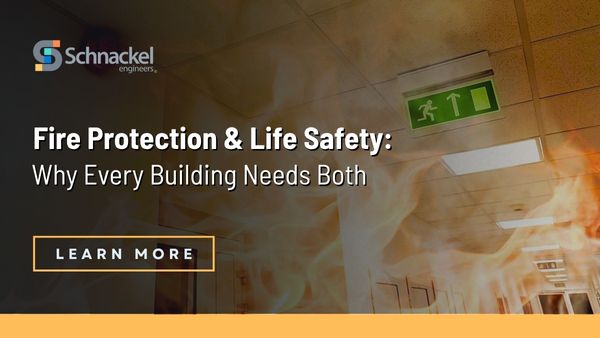Fire Protection & Life Safety: Why Every Building Needs Both

Fire Prevention Week (October 5–11) is a timely reminder that fire safety goes beyond alarms and sprinklers—it’s about protecting people first and property second. For architects, building owners, and facility managers, ensuring that both fire protection systems and life safety strategies are in place is not only a code requirement, but also an important obligation.
This blog explores the fundamentals of fire protection systems, their relationship with life safety, and why the two must work together to keep buildings safe and operational.
What Are Fire Protection Systems?
Fire protection systems are engineered networks designed to detect, contain, and suppress fires before they become catastrophic. These systems include:
- Sprinkler systems automatically activate to control or extinguish flames.
- Standpipe systems provide water connections for firefighting inside multi-story buildings.
- Fire pumps deliver the water pressure necessary for sprinklers and standpipes.
- Fire alarms and detectors offer early warning through smoke and heat detection.
- Backflow preventers and valves keep water systems secure and allow firefighter access.
Together, these systems form the technical backbone of a building’s fire protection strategy.
What Is Life Safety?
While fire protection focuses on detecting and suppressing fire, life safety encompasses the measures that ensure people can safely evacuate and avoid harm. Key life safety features include:
- Fire-rated construction – walls, floors, and doors designed to resist fire spread,
- Egress routes – clearly marked exit pathways and stairwells sized for occupant loads,
- Emergency lighting and signage – guides people during power loss or heavy smoke,
- Smoke control systems – limit smoke migration to keep escape routes clear,
- Notification systems – audible and visual alarms that alert occupants to act quickly, and
- Emergency power systems – generators and battery backup systems that keep the systems operating in the event of a power failure.
Life safety strategies complement fire protection systems, creating a holistic defense against fire emergencies.
Why Fire Protection and Life Safety Are Essential
1. Protecting Human Life
The ultimate purpose of both systems is to save lives. Sprinklers and alarms provide early warning and suppression, while life safety measures ensure people can exit quickly and safely.
2. Preserving Property and Investments
Fire suppression systems minimize damage to structures, equipment, and inventory, while life safety codes help ensure fires are contained and do not compromise building integrity.
3. Supporting First Responders
Firefighters rely on standpipes, indicator valves, smoke control systems, and accessible, protected egress points. Effective fire protection and life safety design make their jobs safer and more effective.
4. Meeting Codes and Standards
The International Building Code (IBC)and National Fire Protection Association (NFPA) standards require both fire protection systems and life safety provisions. Compliance reduces liability and demonstrates due diligence.
5. Maintaining Business Continuity
Fires can halt operations indefinitely. Integrated fire protection and life safety measures limit downtime, allowing businesses to recover faster and with fewer losses.
The Role of Maintenance and Preparedness
Even the best-designed systems fail if neglected. NFPA 25 outlines strict requirements for inspection, testing, and maintenance of fire protection systems. Similarly, egress routes must remain unobstructed, signage maintained, and drills conducted regularly. Preparedness is what transforms systems on paper into lifesaving reality.
Fire Protection and Life Safety: A Shared Responsibility
Fire safety doesn’t stop with the design team or the Fire Marshal. It’s a shared responsibility among building owners, architects, engineers, facility managers, and occupants. Only when fire protection systems and life safety measures are integrated can a building truly safeguard its people and assets.
Conclusion: Building Resilient and Safe Spaces
During Fire Prevention Week, we’re reminded that true safety comes from balance—fire protection systems to detect and fight the flames and life safety strategies to protect and exit the people inside. Together, they create resilient buildings prepared for the unexpected.
At Schnackel Engineers, we specialize in designing and coordinating fire protection and life safety systems that meet codes, protect lives, and preserve investments.
Contact us today to learn how our fire protection and life safety expertise can safeguard your next project.
Comments